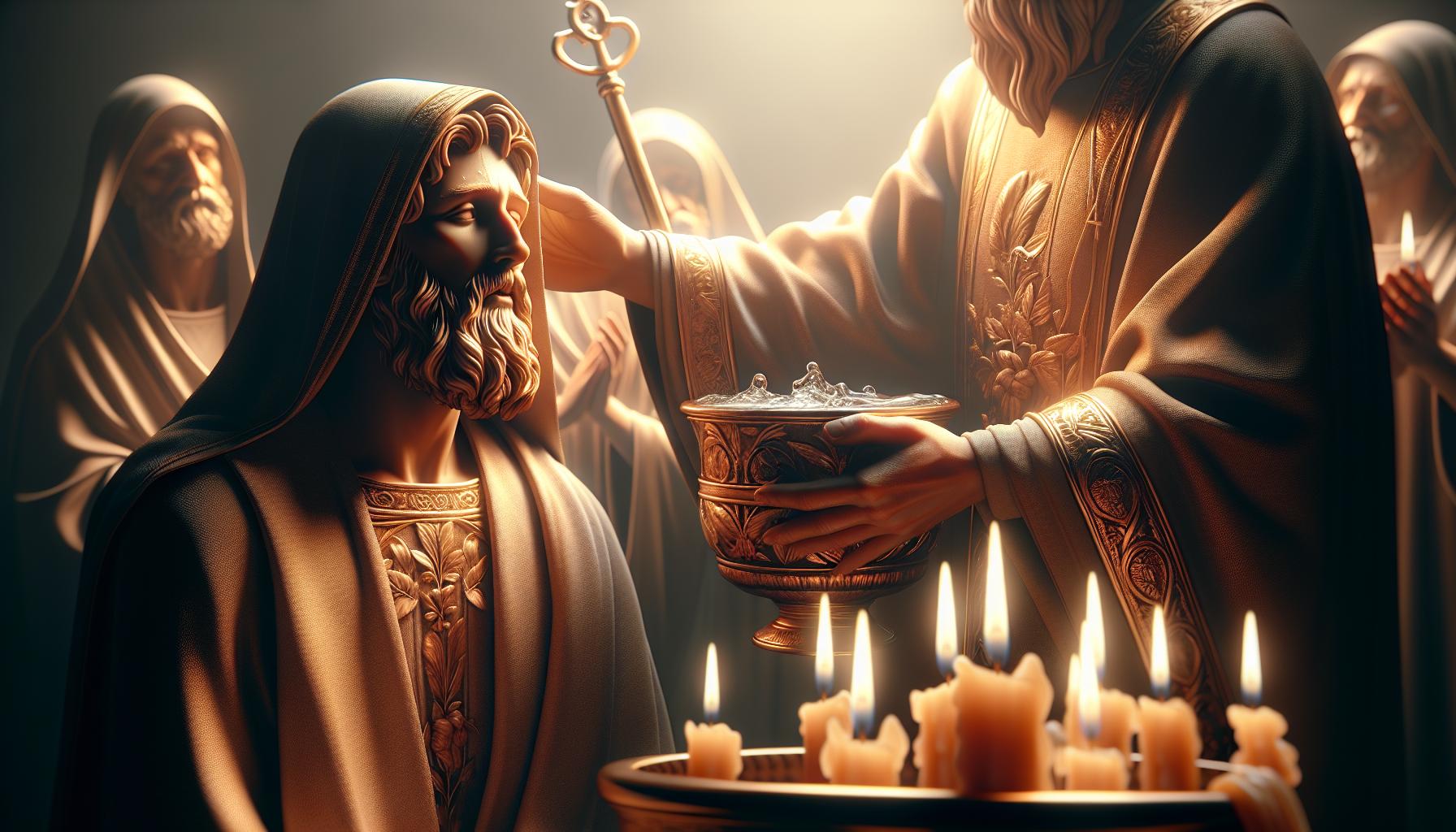Are you wondering how to refer to baptism in Spanish? Understanding the term “bautismo” and its cultural significance is crucial for anyone engaging with Spanish-speaking communities. This article explores the pronunciation, nuances, and traditions associated with baptism in the Hispanic world, enriching your linguistic skills and cultural awareness.
Understanding the Term “Baptism” in Spanish: A Linguistic Insight
Understanding the word “baptism” transcends mere translation; it invites us to explore the rich cultural and historical significance embedded within a single term. In Spanish, “baptism” translates to “bautismo,” a term derived from the Greek word “baptismos,” which means immersion or washing. This linguistic connection reveals the profound layers of meaning associated with the ritual of baptism, emphasizing not only its religious connotation but also its symbolic act of cleansing and renewal.
Linguistic Similarities and Variations
The term “bautismo” can vary slightly depending on the context in which it is used. Here are some notable variants found in different Spanish-speaking regions:
- Primer Bautismo: Referring to the first baptism, typically of infants.
- Bautismo de Adultos: Adult baptism, which is often associated with conversion to Christianity.
- Bautismo por Inmersión: Specifically denotes baptism by immersion, highlighting a common practice in various denominations.
- Bautizo: A colloquial term used, often in casual conversation, interchangeably with “bautismo.”
Each of these terms speaks to the different cultural practices regarding baptism and reflects the nuances of the ritual across diverse communities. From traditional ceremonies in churches to personal baptisms conducted in natural settings, the act embodies a variety of spiritual meanings, celebrated widely throughout Latin America and Spain.
Pronunciation Nuances
Understanding how to pronounce “bautismo” accurately is essential for effective communication. The phonetic transcription is [baw-TEEZ-mo]. Here’s a simple breakdown to help you master this term:
| Syllables | Pronunciation |
|---|---|
| baut | baw |
| is | TEEZ |
| mo | mo |
Focusing on these phonetic elements can greatly enhance your conversational skills when discussing the theme of baptism within various cultural contexts in Spanish-speaking communities. Whether you are preparing for meaningful discussions about religious practices or simply engaging in friendly conversations, incorporating the term “bautismo” can significantly enrich your understanding and connection with the culture surrounding this significant rite.
The Pronunciation Guide: Saying “Bautismo” Like a Local
Understanding the correct pronunciation of “bautismo” can significantly enhance your conversations and interactions in Spanish-speaking contexts. This term, which translates to “baptism” in English, is not only a religious ceremony but also a significant cultural event that resonates deeply within various communities. Getting the pronunciation right is essential if you want to engage with locals genuinely and respectfully.
Pronunciation Breakdown
To say “bautismo” like a local, it can be helpful to break the word down into its syllables: bau-tis-mo. Here are some pronunciation tips:
- Bau: Imagine the English word “how” but start with a “b” sound. This syllable is pronounced like “bow” in English.
- Tis: This part is straightforward—similar to the English word “this,” but with a shorter ‘i.’
- Mo: This syllable sounds like “mow,” as in “mow the lawn,” but with a softer touch.
The stress in “bautismo” falls on the second syllable: tis—making it bau-TIS-mo. Practicing this stress pattern will help your pronunciation sound more natural.
Common Mispronunciations
When delving into how to say baptism in Spanish correctly, learners often misplace the stress or alter the vowel sounds. Below is a table summarizing some common errors to avoid:
| Common Mistake | Correct Pronunciation |
|---|---|
| Bautizmo (with incorrect ‘z’) | Bautismo |
| Bautis-mo (wrong syllable break) | Bau-tis-mo |
| Misplacing stress on ‘baut’ | Stress on ’tis’ |
By practicing these nuances, you can confidently incorporate “bautismo” into your conversations. Emulating the local pronunciation will not only improve your language skills but also enrich your cultural experiences in Spanish-speaking environments. Whether discussing religious traditions or engaging with friends at a local gathering, mastering this pronunciation will reflect your respect for the language and its cultural significance.
The Role of Baptism in Various Spanish-Speaking Cultures
In Spanish-speaking cultures, baptism is not merely a religious rite; it is a significant milestone that intertwines faith, family, and community. The word for baptism in Spanish is “bautismo,” and its pronunciation can vary slightly between regions, usually reflecting local dialects. From traditional ceremonies to modern interpretations, the act of baptizing a child often involves rich cultural symbolism that resonates deeply within families and communities.
Celebration of Identity
For many families, baptism symbolizes not just the individual’s entry into faith but also the embracing of cultural identity. The ceremony often includes a gathering of extended family and close friends, emphasizing the communal aspect of this rite. Common elements of baptismal ceremonies across various Spanish-speaking cultures include:
- Godparents (Padrinos): Traditionally, choosing godparents is a critical component, as they are seen as spiritual guides for the child.
- Candle Lighting: A baptism often features the lighting of a candle, symbolizing the light of Christ and the newfound faith of the baptized.
- Community Involvement: Many families choose to celebrate baptisms during a Mass, integrating the event into the larger community worship experience.
This profound sense of identity expressed during baptism often extends beyond the religious layer, showcasing cultural traditions such as local music, food, and clothing, imbuing the event with personal and regional significance.
Cultural Variations
While the essence of baptism remains unaltered, different Spanish-speaking cultures bring their unique flavors to the ceremony. In Latin America, for instance, the extravagant fiestas following the baptism can be reminiscent of weddings, complete with elaborate decorations, traditional dances, and abundant feasting. In contrast, some regions in Spain might emphasize the simplicity of the ceremony, reflecting a more austere approach to religious observance. Here’s a brief overview of how baptism is celebrated in various cultures:
| Country | Cultural Highlights |
|---|---|
| Mexico | Large family gatherings, traditional music, and colorful decorations. |
| Argentina | Intimate ceremonies often followed by family barbecues (asados). |
| Spain | Simple services, often highlighting community and spirituality over festivity. |
| Colombia | Children often wear traditional attire, and participants engage in local folk dances. |
Understanding these cultural nuances around “bautismo” is essential for appreciating the diverse practices of Spanish-speaking communities. Each rite contributes to the fabric of familial and social ties, showcasing the blending of tradition and modernity in religious observances. By exploring these variations, one gains deeper insights into how communities express faith, identity, and love through a simple yet profound act of baptism.
Exploring the Theological Significance of Baptism Across Denominations
Baptism is a powerful sacrament that transcends cultural and denominational boundaries, deeply rooted in Christian theology. Its significance varies dramatically among the many branches of Christianity, from the meticulous rituals of Catholicism to the more personal expressions found in Evangelical practices. As we delve into the rich tapestry of baptismal theology, one cannot help but appreciate how language and cultural context, such as the Spanish term for baptism—“bautismo”—enrich our understanding and respect for this ancient practice.
Understanding Baptism in Different Denominations
The concept and practice of baptism are viewed through varied theological lenses. Here’s a breakdown of how some major denominations interpret this sacred ritual:
| Denomination | Theological Significance | Ritual Practice |
|---|---|---|
| Catholicism | Believed to remove original sin and incorporate individuals into the Church. | Performed by a priest, often as an infant baptism involving sprinkling or immersion. |
| Orthodox Christianity | An essential sacrament that signifies the individual’s entry into the faith community. | Conducted with full immersion, often in a trinitarian formula, usually at a young age. |
| Protestantism | Varies widely; some see it as a public declaration of faith, while others view it as a means of grace. | Can vary from infant to believer’s baptism; many practice immersion or pouring of water. |
| Evangelicalism | Focuses on the personal commitment of the believer; seen as an outward sign of inward faith. | Typically believer’s baptism by full immersion, celebrated after a personal profession of faith. |
Cultural Context and Linguistic Significance
Language plays a significant role in how we perceive theological concepts. The pronunciation and context of “bautismo” in Spanish-speaking cultures illuminate the universal significance of baptism. In many Latin American countries, baptism is often a communal celebration, emphasizing family and community ties, which reflects a strong cultural inclination towards collectivism.
- Community Involvement: Family gatherings often accompany baptisms, symbolizing the shared faith journey.
- Cultural Rituals: Many incorporate traditional festivities, thus blending cultural heritage with religious practices.
- Language and Expression: Discussing “bautismo” in Spanish opens avenues for deeper discussions about faith, underscoring its relevance in everyday life.
In conclusion, exploring the theological significance of baptism reveals that this ritual is not merely a ceremony but an integral part of the faith journey that transcends language and culture. Understanding how the term “bautismo” resonates in the Spanish-speaking world enhances our appreciation of its rich, multifaceted nature, bridging gaps between diverse communities and helping believers express their faith in vibrant, culturally meaningful ways.
Common Misconceptions About Baptism in Spanish-Language Communities
Baptism holds profound significance in many Spanish-speaking cultures, yet misconceptions abound that can lead to misunderstandings. For many, the core of what baptism entails can become muddled, shaped more by tradition than by the rich theological foundations recognized in various faiths. Addressing these myths is essential for fostering a better understanding of baptism’s role within religious and familial contexts.
Misbeliefs About the Timing of Baptism
One common misconception is that baptism must occur at a specific age or stage in life. Many people believe that infants must be baptized within a few weeks of birth to avoid spiritual repercussions, rooted in the idea of original sin. While this view is prevalent in certain communities, other denominations advocate for a more personal decision to be made later in life, highlighting that baptism is a public declaration of faith rather than a mere checkbox in religious rituals.
Understanding the Symbolism of Baptism
Another misconception is that baptism solely serves as a rite of passage rather than a transformative experience. In reality, baptism is often rich with symbolism, representing both a cleansing of sin and a new covenant with God. It signifies the believer’s commitment to a faith journey, often accompanied by a celebration that includes family and friends. Understanding this deeper meaning can enrich the experience of baptism, moving it beyond tradition to signify a life-changing event.
Cultural Variations in Baptism Practices
Baptism practices vary widely across different Spanish-speaking communities, contributing to the confusion surrounding its significance. For instance:
| Country | Common Practices | Timing |
|---|---|---|
| Mexico | Typically celebrated with a fiesta | Often within weeks of birth |
| Spain | Children often baptized with family attending | Usually within the first year |
| Argentina | Baptism is a significant cultural event often including godparents | Before the age of seven |
The practices of baptism reflect a tapestry of cultural beliefs and expectations. Knowing these variations helps clarify the intent behind baptism, emphasizing the importance of understanding local customs and theological interpretations rather than relying solely on generalized beliefs.
By addressing these common misconceptions, individuals can approach the topic of baptism—whether asking, “How Do You Say Baptism in Spanish? Pronunciation and Cultural Context,” or engaging in conversations about its significance—with a more informed perspective, fostering richer spiritual and communal ties.
Practical Tips for Discussing Baptism in Spanish Contexts
When discussing baptism in Spanish-speaking contexts, understanding both the linguistic and cultural nuances is essential to foster meaningful and respectful conversations. In Spanish, the word for baptism is “bautismo,” pronounced as “bow-TEES-mo.” This foundational knowledge not only enhances communication but also opens a doorway into the rich traditions and significance often associated with this sacrament in various cultures. To navigate discussions about baptism with ease and sensitivity, consider the following practical tips.
Understanding Cultural Significance
Before engaging in conversations about baptism, it’s crucial to appreciate the cultural backdrop. Different Spanish-speaking communities may have distinct customs surrounding baptism, influenced by religious, regional, or family traditions. For instance:
- In many Latin American countries, baptism is often seen as a rite of passage, celebrated with elaborate ceremonies and family gatherings.
- In Spain, it may be a more intimate affair, focusing on the spiritual significance rather than large celebrations.
- Community Involvement: In some cultures, the entire community may be invited to participate, reflecting a collective commitment to the child’s upbringing in faith.
Understanding these cultural differences enables you to approach the conversation with greater respect and relevance.
Using Appropriate Language
When discussing baptism, be mindful of how the term is used in context. Here are some conversational phrases that illustrate how “bautismo” can fit into dialogue:
| English Phrase | Spanish Phrase |
|---|---|
| Have you attended a baptism recently? | ¿Has asistido a un bautismo recientemente? |
| What does baptism mean to you? | ¿Qué significa el bautismo para ti? |
| Can I join your family for the baptism? | ¿Puedo unirme a tu familia para el bautismo? |
Using phrases like these can facilitate an engaging dialogue about baptism while demonstrating respect for the individual’s beliefs and cultural practices.
Encouraging Personal Reflections
Inviting personal stories and reflections can deepen the conversation around baptism. Encourage others to share their experiences by asking open-ended questions such as:
- What was your baptism like?
- Is there a tradition you’d like to pass down to your own children?
- How do you feel about the role of baptism in your faith?
By fostering an environment where individuals feel comfortable sharing their thoughts, you can enrich the discussion and ensure it resonates on a personal level. Being open to learning from others’ experiences is a vital step in cultivating genuine connections and showing your commitment to understanding their cultural context.
By applying these practical tips, you can navigate discussions about baptism with confidence, sensitivity, and an appreciation for the diverse traditions within Spanish-speaking cultures.
The Importance of Language in Communicating Sacred Traditions
Understanding the nuances of language is crucial when exploring how sacred traditions are communicated, particularly across different cultures and communities. Language serves as the vessel that carries rituals, beliefs, and historical contexts, especially in religious practices like baptism. For instance, the term for baptism can vary significantly from one language to another, encapsulating rich cultural meanings. In Spanish, the word “bautismo” not only denotes the act of baptism but also reflects the deep spiritual significance associated with this sacrament within the Hispanic community.
Communicating Sacred Traditions through Language
When discussing sacred traditions, language plays a vital role in preserving and conveying rituals. The way “baptism” is expressed in different linguistics frameworks illustrates how cultural identities are intertwined with spiritual expressions. This act serves not only as a religious ceremony but also as a rite of passage, deeply embedded in social contexts. Different languages may emphasize distinct aspects of the baptismal process; for example, in Spanish culture, “bautismo” often involves family gatherings and communal support, showcasing the collective aspect of faith.
- Preservation of Identity: Language helps maintain cultural identity through the transmission of religious language and practices.
- Emotional Connection: Ritual language evokes deep emotional responses, reinforcing bonds within the community.
- Understanding and Interpretation: Knowledge of specific terms enriches comprehension of sacred texts and rituals, allowing for more profound insights into spiritual beliefs.
Recognizing how to say “baptism” in Spanish—“bautismo”—is more than a mere translation; it is an invitation to understand the cultural significance embedded in the term. Engaging with these linguistic elements enhances cultural appreciation and understanding, allowing individuals to partake in and honor the sacred traditions of diverse communities. As societies continue to evolve, maintaining the language surrounding such profound practices ensures that these traditions remain vibrant and meaningful across generations.
Embracing Diversity: Baptism Practices Within Hispanic Communities
In Hispanic communities, baptism is more than a mere rite of passage; it is a profound social and spiritual event that ties families together, celebrates cultural heritage, and marks a child’s entry into the Christian faith. Understanding the various baptismal traditions within these communities can provide a greater appreciation for their rich cultural tapestry as well as insight into how the term “baptism” is expressed in Spanish: “bautismo.” Often, this practice serves to illuminate not only religious beliefs but also the values and customs that are cherished within Hispanic culture.
Traditions and Variations of Baptism
Baptism practices can differ widely across Hispanic communities, influenced by regional history, local customs, and personal preferences. Below are some of the most common elements found in these ceremonies:
- Family Involvement: Typically, family plays a central role in the baptism process, with chosen godparents (padrinos) being honored for their commitment to guide the child’s spiritual growth.
- Celebratory Feasting: Following the baptism ceremony, it is traditional to gather with family and friends to celebrate, often involving a festive meal that highlights cultural cuisine.
- Religious Symbols: Items such as candles, holy water, and images of saints are commonly incorporated, reflecting the Catholic significance of these symbols in the baptism ritual.
- Specific Dates: Some families may choose to schedule baptisms on significant religious days, such as the Feast of the Epiphany, to reflect deeper spiritual meaning.
Cultural Influence and Community Bonding
Baptisms are also essential for fostering community connections in Hispanic neighborhoods. The event often transforms into a communal gathering, where shared stories, prayers, and blessings reinforce ties among relatives and friends. This communal aspect of baptism can be particularly evident in larger families or close-knit communities, where it serves as a collective affirmation of faith.
In many Hispanic cultures, the concept of “compadrazgo” plays a crucial role, referring to the special bond established between the child’s parents and the godparents. This relationship transcends the baptism event, often extending into lifelong support and friendship, showcasing how intertwined personal and spiritual lives can be.
| Element of Baptism | Description |
|---|---|
| Godparents (Padrinos) | Chosen individuals who will guide the child spiritually. |
| Ceremony | A religious rite conducted in a church, often accompanied by prayers and blessings. |
| Celebration | Post-baptism festivity with food, drinks, and social gatherings. |
Understanding baptism within Hispanic communities highlights not just a single event but an entire ecosystem of cultural values, familial ties, and community spirit. Such insights align closely with the broader context of “How Do You Say Baptism in Spanish? Pronunciation and Cultural Context,” prompting further exploration into how personal and communal identities are shaped through these significant rituals.
Q&A
How do you say baptism in Spanish?
The word for baptism in Spanish is bautismo. Pronounced as “bow-TEES-mo,” this term is universally used in Spanish-speaking cultures to describe the Christian sacrament of initiation.
To Conclude
In summary, understanding how to say “baptism” in Spanish—bautismo—opens up a world of cultural and theological richness that transcends language barriers. By exploring the pronunciation and the significance of baptism within various Christian traditions, we’ve uncovered not just a term, but a profound expression of faith.
As you continue your journey, consider how this sacred practice speaks to your life and the lives of those around you. Whether you are preparing for baptism, participating in a service, or engaging with diverse faith communities, each opportunity to share and discuss such a pivotal rite enriches our collective understanding.
We encourage you to dive deeper into the practices, literature, and local customs surrounding baptism in different cultures, and to reflect on how your own beliefs intersect with this sacred tradition. Your exploration not only enhances personal faith but also fosters community connections. Thank you for taking this enlightening journey with us—may it inspire further learning and connectedness in your faith walk.





